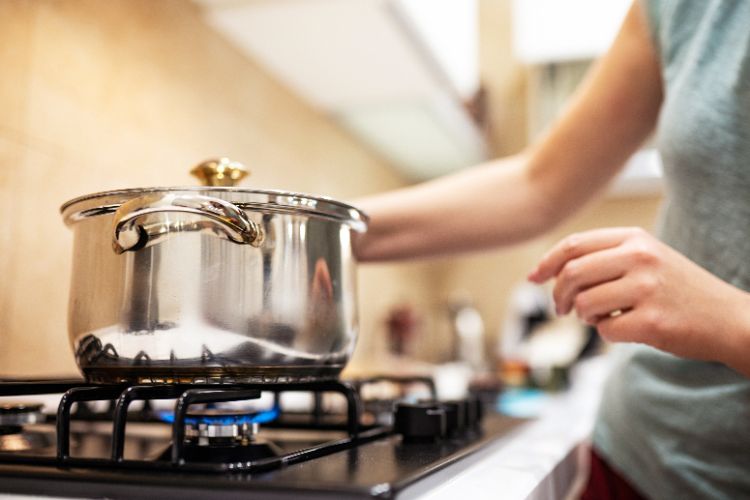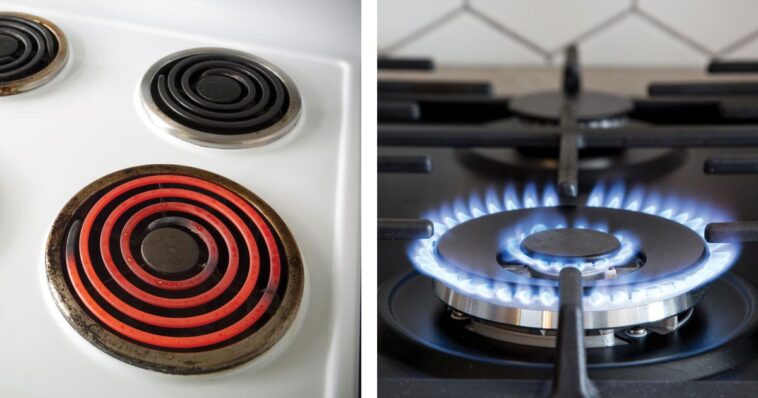It’s an age old debate: gas stoves vs. electric stoves. Many people base their preferences on what they grew up on, and there’s nothing wrong with that. After all, if one was in your home throughout your earlier days, there’s a chance you probably used it to cook as you got a little older too, so you became more familiar with it. But personal preferences and nostalgia aside, which is truly better for cooking: a gas or electric stove?
It’s hard to say that any one is actually the right choice for everyone, and there’s more to this than simply what kind of stove we’re all used to seeing in our kitchen. These two different types of stoves cook food differently. So the preferred choice may depend on what you cook most often. Then there are also other household considerations. How safe do you need your stove to be? And how much are you willing to pay in utility costs throughout the year? We dig into these, and more, with a full analysis of gas vs. electric below.
1. Gas stoves are cheaper in the long run

Purchasing a new stove is going to be a big investment; there’s just no way around that. And it can be difficult to compare whether gas or electric will be cheaper for you upfront because of their different price ranges. If you’re going very low-end, you’ll probably get a bit of savings with an electric since they tend to start at around $650 while gas stoves typically start at around $800.
But if you’re looking for something a little higher end, you could end up paying up to $2,800 for an electric stove while the best gas stoves can be had for about $2,300. There’s a difference at both ends of the scale, but it’s not much considering the big investment stoves are to begin with.
It’s really in the long run that you’ll see the difference. And this too can be difficult because utility rates vary widely from state to state. Generally speaking however, gas is usually the cheaper option over electricity. And if that’s important to you, it’s good to know that investing in a gas stove will save you anywhere from 10 to 30 percent in utility costs every year.
2. Electric stoves are safer

There’s no way around this one: electric stoves are the safest option, hands down. The trademark of a gas stove is the flame that ignites as soon as the burner is turned on. And while that flame can be good for a lot of things, it can also be dangerous. Children can easily become enthralled with that flame and want to touch it, resulting in some pretty serious burns.
And large pets such as dogs can become interested in the good smells coming from the stove top and jump up to investigate, burning their noses and paws as they do. Items such as tea towels can wooden spoons kept too close to that flame can also catch fire and become a dangerous situation.
While it’s not impossible to get burned from an electric stove, it’s certainly not as easy to do. And the one safety feature gas stoves have that electrics do not is the fact that it’s easy to see when a gas burner is hot because of that flame. On electric stoves, a burner can stay very hot when it’s turned off but not have the same type of indicator. Those who are cleaning the stove-top, or even just brushing up against it, can get burned. Still, with burners that don’t have an actual flame and are often even set into the actual stove-top providing for a smooth finish, it’s much harder to burn one’s self on an electric stove than it is a gas stove.
What really wins the safety category for electric stoves though is that when they’re off, they’re off. And even when they’re on, they’re not going to be emitting anything more than heat. Gas stoves on the other hand can leak gas, which is why any home outfitted with one should also have a carbon monoxide detector nearby.
3. Gas stoves cook food more quickly
This is one of the reasons so many restaurants use gas stoves – they can significantly cut down on the cook time of any dish. Gas stoves and their elements heat up far quicker than electric stoves. With an electric stove you have to turn the button and wait for the burner to get hot enough to heat a pan you’ve placed on top of it. That can take a while. But with a gas stove you simply ignite that burner and the flame starts to heat up the pot immediately.
4. Electric ovens cook more evenly
Moving from the stove-top to the oven, electric ovens win the battle. Gas emits a bit of moisture while it’s being used for cooking, which produces a wetter heat in the oven. Electric ovens however, have just heat and heat alone and that produces the dry heat that perfectly cooks roasts and baked goods. Gas stoves also don’t cook food as evenly as electric stoves, but that doesn’t mean they can’t be used. It just means that food should be placed further away from the heat source and should also be rotated regularly during cooking time.
5. Gas stoves can simply do more
While gas ovens may be a bit higher-maintenance than electric stoves, there are some things that gas stove-tops can do that electric stove-tops just can’t. This includes flambeing, charring, and even toasting more effectively than electric stoves. This is another reason why they’re a favorite of restaurants, and of dedicated home cooks.
6. Electric stoves are easier to clean
No one wants a messy stove-top in their kitchen and if being able to easily clean it is a priority to you, you may want to opt for electric. Flat-top electric stoves win the cleanliness battle hands down. A simple swipe over the stove-top with a damp sponge will likely take away most messes. And even electric stoves with coil burners are not that difficult to clean. You just have to take out the burner, clean the plate underneath, and then plug the burner back into the element. Even when it’s been a while since you’ve cleaned your stove, the job shouldn’t take more than a few minutes.
With gas stoves on the other hand, there are heavy grates that need to be taken out and in many cases, those grates have many different parts that are easy to break. Cleaning gas stoves can take some time and if you’re not careful, you could lose an important piece of equipment.
Source: cookingtips.cooktopcove.com
